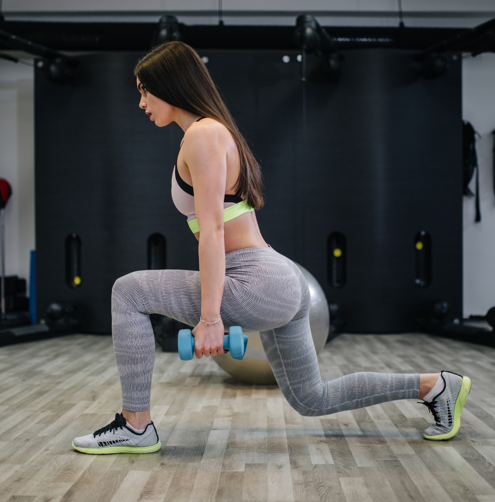

Both lunges and split squats have their place in programs.
They can increase muscle size and strength by focusing on one leg at a time.
If you're used to doing only squats for your leg workouts, then try using one of these exercises as they'll help strengthen your weaknesses.
When it comes to unilateral training for the lower body, split squats and lunges top the list.
Both exercises involve squatting in a staggered stance.
So, it’s no surprise that some people get confused between them.
Both split squats and lunges are effective at strengthening the quads, glutes, and hamstrings of each leg separately.
However, they each have their unique benefits.
In this article, I’ll go in-depth on the key differences and benefits between split squats and lunges.
Check out our other article on bicep curls (hammer vs bicep curls).
The main difference between split squats and lunges is that the split squat does not involve changing the position of your feet, while the lunge does.
In other words, split squats are a static exercise while lunges are a more dynamic one.
The split squat has you starting in a staggered stance.
To perform the movement, you stay in that position and lower into a squat.
With the lunge, however, you start with your feet at shoulder width and then take a step forward to go into a staggered stance.
The split squat targets the quadriceps and the gluteus maximus.
The degree to which the exercise works either of these muscles depends on how far apart your legs are.
The wider your stance, the more it will work the glutes.
When you’re doing the lunge, your core muscles act as stabilizers. So do your calves, tibialis, and hamstrings.
Lunges target the same muscles as the split squat; the quads and glutes.
However, because there are different ways to do the lunge, you can more directly target different lower body muscles than when doing split squats.
When you perform a forward lunge, you are targeting the quadriceps.
However, the rear lunge, where you step backward, switches the emphasis to the hamstrings and glutes.
Side lunges will more directly work your adductor and abductor thigh muscles.
The split squat can be done with a barbell across the shoulders or with weights in your hands.
The following description relates to the barbell version of the exercise.
To perform the hand weighted version, simply hold a pair of dumbbells at your sides.
Alternatively, you can hold a single kettlebell in front of your chest with both hands.
Split squats can also be done with the rear foot on a box or bench.
This version of the exercise is called the Bulgarian split squat.
The lunge can also be done with a barbell, dumbbells, resistance bands, or a kettlebell.
The following description is for the barbell version.
No, split squats and lunges are not the same thing.
The key difference between them is that the split squat keeps your feet in one position, while the lunge involves taking a step forward and then back on each rep.
Split squats are better than lunges at developing balance and coordination.
They also allow for heavier weight so are better for hypertrophy.
However, lunges are more effective for muscular endurance.
They also allow you to target different muscles of the legs through variations such as rear lunges, which target the hamstrings and glutes.
The Bulgarian split squat involves placing your rear foot on a platform such as a box or a bench.
It allows you to get a greater range of motion than the standard split squat version of the exercise.
What is the main difference between a split squat and a lunge?
The primary difference between a split squat and a lunge lies in the movement of the feet. In a split squat, your feet remain in a fixed, staggered position throughout the exercise. On the other hand, lunges involve dynamic movement, where you start with your feet at shoulder width and then take a step forward into a staggered stance.
What are the benefits and drawbacks of split squats?
Split squats are excellent for improving balance and coordination as they require you to maintain a one-legged position for a longer duration than lunges. They are versatile and can be performed with various equipment like barbells, dumbbells, kettlebells, or resistance bands. However, they require a decent amount of balance to start with and may pose a challenge to work both legs evenly. Also, the range of motion in split squats is limited compared to lunges.
What are the benefits and drawbacks of lunges?
Lunges are functional exercises that simulate everyday movements like walking up stairs or getting up from a half-kneeling position. They improve proprioception, strengthen stabilizer muscles, and have a greater cardio effect than split squats. However, lunges may cause knee pain if performed incorrectly, and there's a risk of overstretching the groin area if you take too large a step forward.
When should I do a split squat and when should I do a lunge?
You should consider doing a split squat when you want to work each leg separately, improve your explosive strength, or when you're unable to do barbell squats. On the other hand, lunges are ideal as part of a CrossFit routine, when you want to improve your proprioception, balance, and coordination, or when you want to enhance the endurance of your lower body.
Which muscles are targeted by split squats and lunges?
Both split squats and lunges target the quadriceps and the gluteus maximus. The degree to which these muscles are worked depends on how far apart your legs are. In split squats, a wider stance will work the glutes more. In lunges, different variations can target different lower body muscles. For instance, a forward lunge targets the quadriceps, while a rear lunge emphasizes the hamstrings and glutes.
Both the split squat and the lunge are effective unilateral exercises for the lower body.
Either one of them will work the quads, glutes, core, and hamstrings.
However, for strength and muscle gains, the split squat is the better option.
If you want to target your hamstrings or adductor and abductor muscles, lunges are the way to go.
Useful Links
 About FitFrek
About FitFrekFitFrek operates as an independent platform, offering comprehensive workouts, programs, routines, guides, and unbiased reviews to accelerate your progress. We pride ourselves on our honesty, delivering straightforward and candid insights. FitFrek does not offer medical advice, diagnosis, or treatment services.